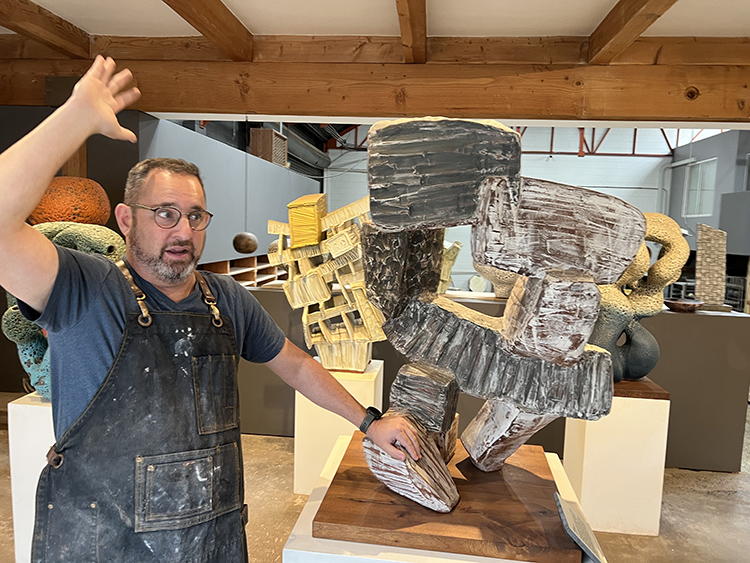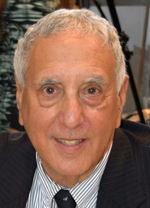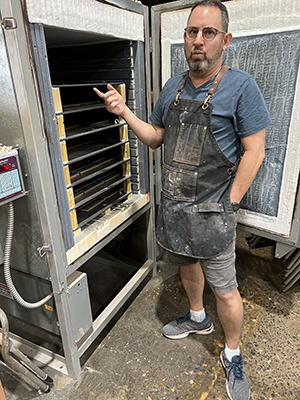
By Donald H. Harrison and Emily Scalmanini


SAN DIEGO – Ceramicist Josh Herman’s tile work is on display throughout the upscale Paridisea Restaurant in the remodeled interior of the Piano Building in La Jolla’s Bird Rock neighborhood. His “modern, sensual, organic” ceramic sculptures made the cover of the French edition of Architectural Digest in July 2016 when the authoritative magazine profiled the La Jolla Farms Road home known as the Razor House, now owned by singer Alicia Keys.
“Bruise” is one of the pieces that Architectural Digest featured in that edition. The 41” x 29” x 20” multi-piece sculpture was constructed using slabs with each block built directly on the structure. “This method gives the piece a unique blend of mass and movement,” Herman commented. “Bruise was always on the edge of falling apart. It was a tenuous process every step of the way. I was experiencing a good deal of emotional pain and discomfort during the making of Bruise; it shows well in the piece.”
Interviewed Sept.29 in his studio converted from a former auto repair shop in the Barrio Logan neighborhood, Herman shared a story behind his Architectural Digest coup.
An exhibition of his works had been installed at La Jolla Country Day School where his daughter Gabriella, now a freshman at Tulane University, and younger son Isaac were then young students. They had asked him to exhibit his work and “of course, I agreed.” Over Christmas vacation, while the school was locked up, the call from Architectural Digest came. The architect Wallace Cunningham had designed a thin-looking house tracing the contours of a cliff with a panoramic Pacific Ocean view.
“When they got to the house, there was nothing in the house,” Herman related. “There was a couch, but no one was really living in the house. They were kind of desperate. They called me and said, ‘Josh, we’re doing this shoot. Could you bring some of your work so we could put it in the house? We will give you the cover.’ … So, I said, ‘yes, of course, but everything was at La Jolla Country Day. So, we started frantically making phone calls. We got a friend who was one of the administrators to open up the school. I had to go to the school in the middle of Christmas break, take down the whole exhibit – and these are not easy to move –by myself, take it, and load it into my truck, and bring it over to the photo shoot. I did the photo shoot for two or three days, where I stayed with them and put this or that in different rooms. I got to hang out with cool, interesting people at this great house. After that was done, I had to bring everything back and reset it up, so nobody knew it was taken down. And now Alicia Keys has bought the house.”
We asked Herman about a nearby piece in his showroom, which might have been called “Northridge 1994” because it looked like what might have befallen an apartment building following that year’s massive earthquake.
In fact, the piece was one of the many in his studio’s showroom that Herman had not named, but he greeted the suggestion with a story about the big temblor. “My teacher was a guy named Paul Soldner,” Herman said. “He’s deceased, but he was a seminal person in contemporary ceramics and very well known in the ceramics world. Every year there is an exhibition at (Pitzer College in Claremont, California) called the Scripps Annual. All these clay artists are invited from all over the country and there is a big party and it is a big deal. They had just set up the Scripps Annual and they had the big earthquake. I was in the studio when it happened. I happened to be at the door, so I ran out. It was wild. The actual earthquake was crazy.”
“Afterwards everyone was asking ‘Are we all okay?’ as we had just put up that exhibit of ceramics,” Herman continued. “So, I go walking up there with Paul. He was an older guy. He was walking around, a little stogy in his mouth, and we go into the exhibit and everything was destroyed. Everything had fallen from the earthquake. We looked at each other, me and the other students. ‘What’s he going to do?’ He kind of growled through his stogy and said, ‘Just leave it; we will show it like this,’ and that year that was what the exhibit was, the destroyed exhibit from the earthquake. He was really cool, an interesting guy. I take a lot of influence from him.”
In that Soldner was taught by ceramicist Paul Voulkos, the founder of the ceramics departments at UC Berkeley and at the Los Angeles County Art Institute, Herman considers himself part of the Voulkos-Soldner artistic lineage. But other important influences on his work were Isamu Noguchi and Ruth Duckworth, the latter the daughter of a German Jewish father who escaped Nazi Germany in 1936 to pursue her career as a modernist sculptor in the United States.
Both Bruise and the piece that inspired our earthquake conversation were made of slabs during a period when Herman decided he “wanted to make something more rough and raw, rather than pretty.” This contrasted with other “more organic, curvilinear types of works,” utilizing coils that look like “snakes of clay. Most of my work had been in that curvy, sensuous style.”
“Bruise,” said Herman, “looks heavy but it also has movement to it, and that is what I like—a weightiness and a lightness, and it has this negative space, so it is kind of lifting off the table. It has this type of kinetic energy to it that I really like. I find that this is one of the successful pieces.”

Asked why most of his pieces are unnamed, he responded. “Names are not that important to me. If you look at my work, there are not a lot of literal associations. They are very abstract, so the names are sort of secondary. The pieces are intentionally not conceptual. I think in our culture we are too much in our heads, too intellectual. So, my work, I don’t want it to be a concept, so names are less important. People will have their own associations.”
Down a short flight of steps from the showroom is Herman’s actual workspace. There are eight potter’s wheels there, and Herman plans to increase that number to 16 in preparation for opening his studio sometime around the secular New Year to membership, where other ceramic artists can work in a venue well supplied with kilns, clays, glazes, and tools. He also plans to teach classes there.
We sat down to learn more about the metropolitan New York born-and-raised ceramicist and his wife Rachel, who handles administrative matters for Herman’s studio. Growing up, he was more interested in sports than in art, lettering in high school in soccer and tennis. “I was always physical with my body,” which is helpful in his current work, he said. “Making ceramics from clay is an experiential, tactile activity,” he explained. “You are very much using your body, and in your body, as opposed to when you are on the phone.” Herman also likes to garden and to cook. “To me it’s all in the same category – cooking, ceramics, gardening. They are all work with your hands, your body, and creating something.”
He came out to California as an undergraduate at Pitzer College, returning after several years to New York City, where he enrolled as a culinary student in a four-month program at National Gourmet. “The first day, 9 a.m. to 5 p.m., the first morning I was there, I am habitually early,” Herman recounted. “I was the first one in the kitchen. I sat down at the tables and was just waiting for other people and for it to start. The next person who came in was Rachel. She came in and sat down right next to me. She could have sat anywhere but she sat down right next to me, and we hit it off. It was a full-time program, so we were there all day every day. So, we had a lot of time together.”
We asked Rachel why she sat down next to him. “It was so unlike me, first of all, to be so early but that was because I took a train in from New Jersey to Manhattan, so based on the train schedule I was arriving early,” she said. “Walking into a room, I would ordinarily acknowledge the person already there, but maybe sit on the other side. Something happened. I sat right next to him.”
Their meeting seemed bashert (fated).
While Josh was raised in an unaffiliated Jewish home, keeping in touch with such Jewish practices as Passover seders at his grandparents’ home, Rachel had been raised in a Jewish family that was very much involved in the Monmouth Reform Temple (MRT) in Tinton Falls, New Jersey. That was the congregation where Rabbi Sally Priesand, the first woman to be ordained as a rabbi, was the spiritual leader. Priesand used to tell a story about Rachel’s brother, David Gitlin, when he was a little boy. He looked up to her one day and asked, “Rabbi, can boys be rabbis too?”
Rachel’s parents served as officers of the synagogue, and Rachel, herself, was a youth leader. Rachel recalled that “My mom was on the MRT pulpit search committee when Sally Priesand was hired and had her first Shabbat dinner as our rabbi in our home. There was a rainbow that early evening and from then on every Rosh Hashanah when the liturgy mentions a rainbow, Rabbi would look to my family and smile.”
When Rachel and Josh became more serious in their relationship, Rachel made it clear that she wanted “to have Judaism as part of our family life and to raise Jewish children,” she said. “It has worked out. I think our Judaism is a way to have family time. I participate in Jewish organizations in San Diego. I am on the board of Women’s Philanthropy at the Jewish Federation. I served on the board of the JCC for a decade.”
The Hermans are members of Congregation Beth Israel. Their son, Isaac, today a high school junior, was part of a Camp Mountain Chai visiting delegation to the Dominican Republic. He furthered the cause of the Butterfly Project, by having ceramic butterflies painted and mounted in public spaces there. The Butterfly Project seeks to have 1.5 million such butterflies placed throughout the world in memory of the 1.5 million Jewish children who were murdered in the Holocaust.
Today, Rachel does most of the family’s cooking, while Josh tends to an extensive garden at their home.
Josh Herman told us that he never knows what he will create when he sits down to make a sculpture.
“I don’t know that it is unique but I don’t think it is a traditional way of creating pieces,” he said. “I think it is one of the things that makes me who I am – that sort of improvisational discovery process. A lot of artists would sketch, or remake a piece and refine it, but I never really took that approach. I liked not knowing what I was embarking on and being open to feedback from the piece itself and making decisions as I would build.”
“In so doing, I would get pieces that I never would have thought of or conceptualized ahead of time,” he continued. “To me, that is exciting, to work on something and to have something appear out of the ethers. That’s accessing a place deeper than the consciousness. You are going into the unconscious realm at that point, really discovering something about yourself, and trying to create something in a three-dimensional form.”
“That is an expression of who I am on a deeper level than the thinking level, the conscious level,” he elaborated. “So, to me it is a naturally unfolding process. It is a natural way of things in the world. I follow that natural form and work with natural material and collaborate with it to make these forms and to learn about myself and the world.”
Herman said “one of the unique and wonderful aspects of ceramics is that if you just touch it, it leaves a mark. It is the most sensitive material. The temperature, the wind that comes through the door will influence it. What I ate for breakfast, my energy level, it all influences it. It captures everything. If I made a piece when it was 90 degrees outside, it would look different than if I made it at 40 degrees and raining.”
Working in clay “is very meditative,” Herman told us. “It is a great way to process your own emotional upheaval, pleasure, or pain.”
Herman’s studio is at 2295 National Avenue, San Diego, behind tall cacti that partially obscure a wrought iron gate. His list of clients includes The Old Globe Theatre, the Ritz Carlton Hotel, HBO, ABC, Virgin Hotels, and the Bel Air Hotel. Many of his works are in private collections.
*
Donald H. Harrison is editor emeritus of San Diego Jewish World. Emily Scalmanini is a history major at the University of San Diego, currently interning with Harrison on a series of Jewish stories found in the vicinity of the Interstate 15 freeway.